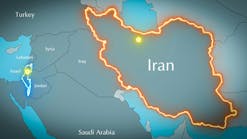Underground storage played a big role in helping U.S. gas pipelines meet a demand surge during the 1995-96 winter, the coldest in more than a decade.
American Gas Association data show a net withdrawal of more than 2.4 tcf during that heating season.
AGA Pres. Michael Baly said, "There was pressure on storage from the beginning of November right into April. In fact, to meet demand, some companies were forced to withdraw volumes of what had been classified as 'base' gas from several facilities. However, the bottom line is that the industry performed and performed well."
Baly called performance of AGA member company deliveries to firm customers from all supply sources, including underground storage, "excellent." Meantime, AGA reports a 26% reduction in gas pipeline transmission and distribution (T&D) costs since 1987 has helped reduce prices for U.S. consumers.
Storage withdrawals
AGA said for the 1995-96 heating season, the coldest since 1983-84, storage volumes bottomed out about Apr. 12, when only 546 bcf, or about 17% of estimated working gas capacity, remained in storage.
The largest weekly withdrawal during the period was 213 bcf, compared with a high week of 253 bcf during the 1993-94 winter.
Baly said, "We believe this lower level of storage is a sign of increased efficiency on the part of the various segments of the natural gas industry. Improvements in inventory management mean lower costs for the consumer and increased profitability for our members."
There was less than 3 tcf in storage at the beginning of the heating season, which was lower than the preceding year. The reduced volume stemmed from hurricane related production interruptions, requirements for gas in electrical power generation, and industry's unwillingness to overfill underground storage.
Retail prices
AGA reports the average retail price of U.S. natural gas fell to $3.53/ MMBTU in 1995 from $4.80 in 1987. Average retail prices, after removing the effects of inflation, fell 26% during that period.
David Biegler, AGA second vice-chairman, attributed 70, or 55%, of the price slide to declining T&D costs, compared with a 57, or 45%, drop in the wellhead cost of gas.
Biegler, who is chairman, president, and CEO of Enserch Corp., Dallas, said, "The cost of transporting and distributing natural gas to every region of the country has been reduced as the result of productivity improvements and cost cutting measures.
"Steady and significant T&D cost reductions have been achieved despite fluctuating wellhead prices and the fact that some costs downstream of the wellhead, including a variety of federal and state mandated programs, are beyond the control of gas companies."
He also said there is no question that gas consumers have benefited from increased competition in the gas marketplace since wellhead price decontrol and open access transportation on the nation's distribution and interstate pipeline systems.
An AGA study shows all U.S. regions benefited from declining gas T&D costs ranging from 9% to 37%.
Also, all consuming sectors realized T&D cost reductions, ranging from a 42 decline for electric utilities to a 67 decline for industrial customers. The residential T&D cost decline was 55 during 1987-95.
Gains in labor productivity accounted for part of the drop in average T&D costs, with average gas deliveries to consumers per worker rising 35%.
Copyright 1996 Oil & Gas Journal. All Rights Reserved.


